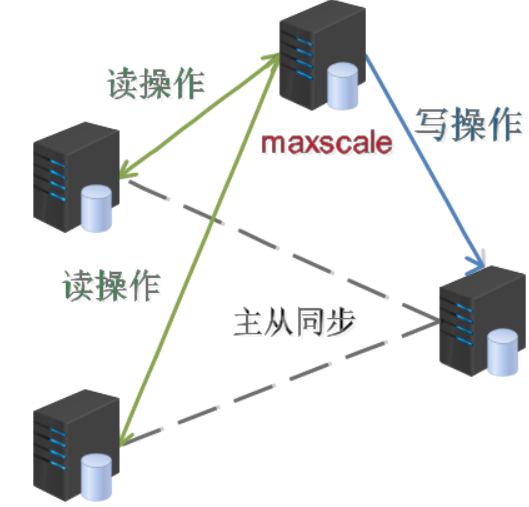Mysql read write separation
The query request and write request of client accessing data are processed by different database servers respectively.
Why data read-write separation
Reduce the concurrent access pressure of single server and improve the utilization of machine hardware
The server that processes and writes data is the master, and the read data server is the slave.
Configure data read-write separation (Maxscale + master-slave synchronization)

1. Deploy one master (101) and two slaves (102103)
2. Install maxscale-2.1.2-1.rhel.7.x86_.rpm on 150
Modify the configuration file / etc/maxscale.cnf and add two server s
[maxscale] threads=auto #Number of threads running [server1] #Define database server type=server address=10.10.10.101 port=3306 protocol=MySQLBackend #Back end database [server2] type=server address=10.10.10.102 port=3306 protocol=MySQLBackend [server3] type=server address=10.10.10.103 port=3306 protocol=MySQLBackend [MySQL Monitor] #Define the database server for monitoring type=monitor module=mysqlmon servers=server1,server2,server3 #The monitored database list cannot write ip user=scalemon #The user name of the connection when monitoring the database server: scalemon passwd=123456 #Password 123456 monitor_interval=10000 #The frequency of monitoring is in seconds [Read-Write Service] #Define read write separation service type=service router=readwritesplit servers=server1,server2,server3 user=maxscaled #User name verifies the existence of the user accessing the database server when connecting to the agent service passwd=123456 max_slave_connections=100% [MaxAdmin Service] #Define management services type=service router=cli [Read-Write Listener] #Port number used by the read-write service type=listener service=Read-Write Service protocol=MySQLClient port=4006 [MaxAdmin Listener] #Port number used by management service type=listener service=MaxAdmin Service protocol=maxscaled socket=default port=4099 #Add manually. If not specified, the default port is used. After starting the service, you can know what the default port is.
3. Add monitoring users and routing users to the two servers according to the settings of the configuration file
replication slave #Monitoring master-slave synchronization replication client #Monitoring service status grant replication slave,replication client on *.* to scalemon@"%" identified by "123456" grant select on mysql.user to maxscaled@"%" identified by "123456"
4. Start service on 150
Verify authorized users Start service: maxscale -f /etc/maxscale.cnf Stop service: Kill - 9 maxscale
5. Test configuration
View management information (150 hosts access themselves) maxadmin -uadmin -pmariadb -P4099 list servers Client connection 57 access data
6. Test data read-write separation
Users authorized to access on the primary database
The client connects to the middleware server: mysql-h10.10.10.150-p4006-uyaya8-p123456